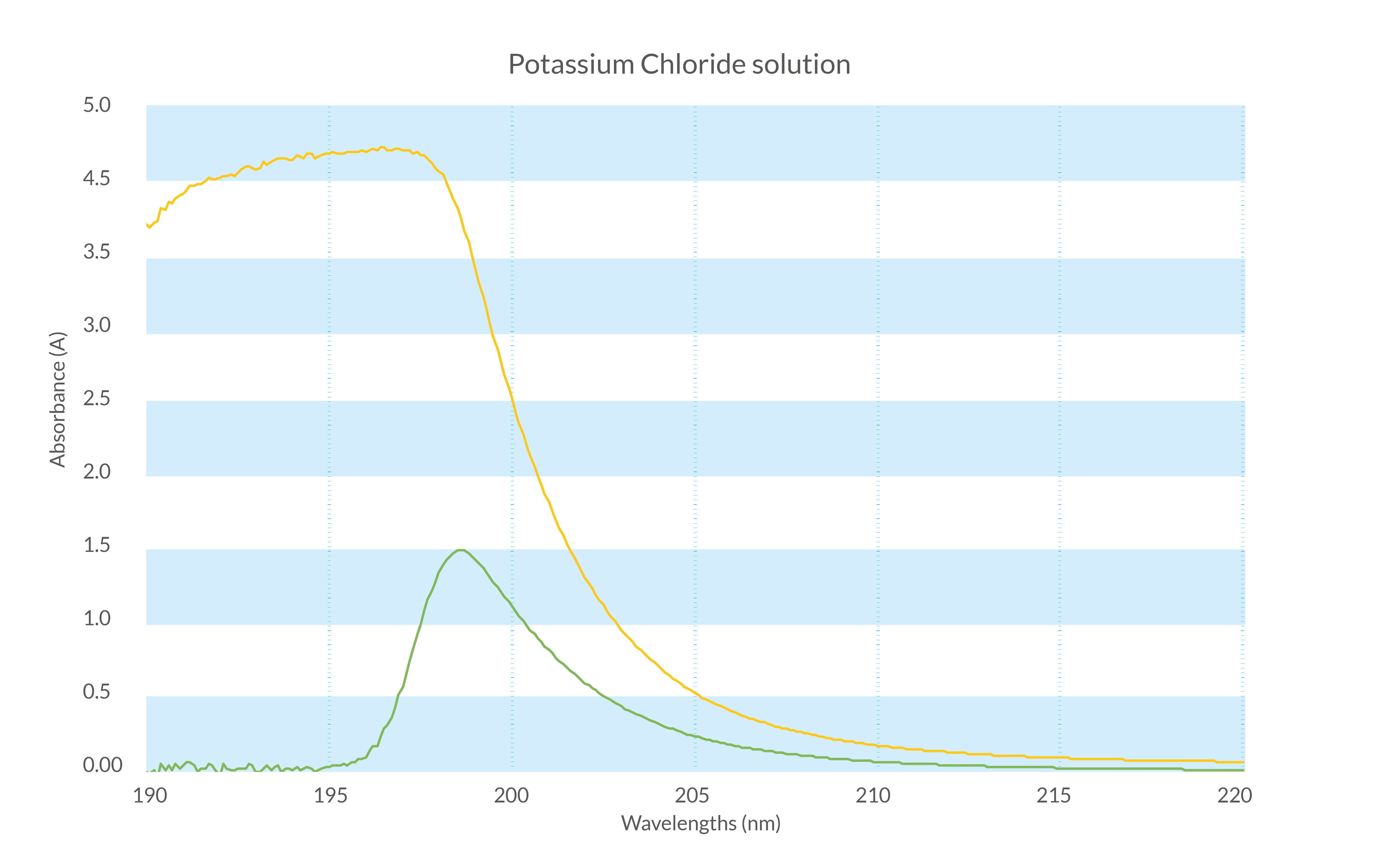Purpose
These Reference Materials can be used to qualify the stray light (or Stray Radiant Energy) of Ultraviolet (UV) spectrophotometers according to the Filter Ratio or Mielenz method. This method is described in ASTM International E 387 and is cited for instrument qualification by the US Pharmacopeia in its Chapter (Method A). This method is useful for instruments with very low stray light, such as double monochromator systems.
Description and Discussion
A range of cut-off filter solutions that allow stray light to be checked at a range of wavelengths from 200 nm to 390 nm. Each liquid filter is permanently sealed by heat fusion into a 10 mm high quality far UV quartz cell and a 5 mm path length cell (in the conventional 10 mm format) of the same liquid. The 5mm cell is used to provide a differential reference to the measurement of the 10 mm cell (see explanation below). Starna alkali halide stray light Certified Reference Materials are prepared in accordance with ASTM International E-387.
Stray light, also called Stray Radiant Energy or Power, is any light reaching the detector that is outside the Spectral bandwidth selected for analysis by the monochromator. It can be due to optical imperfections or stray reflections within the monochromator itself or to light leaks or other effects in the rest of the optical system. As the detector cannot discriminate between the analytical wavelength and the stray light, the stray light contributes to the detector signal and introduces an error in the measured absorption. The stray light is not absorbed even at high concentrations of the absorbing species, so its effect is a negative deviation from the linear relationship between concentration and absorbance (the Beer-Lambert law) on which most quantitative determinations are based.
Stray light is wavelength and instrument dependant. It can be present at any wavelength but is most noticeable when the energy throughput of the system at the analytical wavelength is relatively low, for example in the far UV region, and any stray light will be comparatively more significant. At these wavelengths, any deterioration in the instrument optics or UV light source will exaggerate the apparent stray light, so It is desirable to check it even if the instrument is not to be used in the far UV, as it is an excellent way of monitoring the condition of the instrument optics.
With instruments having very low stray light, such as double-monochromator systems, the Specified Wavelength method may generate very high absorbance values, requiring considerable ‘backing-off’ to achieve an on-scale reading. In the Filter Ratio, or Mielenz method, the reference materials are measured not against water, but against a 5 mm path length cell containing the same solution. This has the effect of “backing off” the measured absorbance, resulting in a direct measurement.
Typical spectra
Spectra obtained with a Potassium Chloride reference material using the two methods are shown below.

The differential absorbance value (ΔA) at the peak is related empirically to the Stray-Light level (s) by s = 0.25 x 10 –2*ΔA Practically, this means that an instrument exhibiting 1% stray light would give a differential absorbance value at the peak of > 0.7A. This is the instrument qualification requirement of the USP. These typical spectra were recorded on three instruments with different stray light characteristics:

The peak wavelength is different on each instrument due to their different stray light characteristics, but in all three cases the absorbance maximum is greater than 0.7A, so all these instruments satisfy the USP stray light requirement.
For comparison purposes, the equivalence of the two test methods is indicated in the table:
| Filter Ratio Absorbance (Δ A) | Specified Wavelength Absorbance (A) |
| 0.3 | 1.3 |
| 0.5 | 1.6 |
| 0.7 | 2.0 |
| 1.0 | 2.6 |
| 1.5 | 3.6 |
| 2.0 | 4.6 |
| 2.5 | 5.6 |
An instrument giving an absorbance of >2.0 A using the Specified Wavelength method should give a differential absorbance of >0.7A using the Filter Ratio method.
| Material | CONCENTRATION | Scan Range | Usable Range | Catalogue Number |
|
Sodium Nitrite |
50 g/l aqueous |
300 - 400 nm | 300 - 385 nm | RM-SN/5 |
|
Acetone |
Spectroscopy grade |
250 - 330 nm | 250 - 320 nm | RM-AC/5 |
|
Potassium Iodide |
10 g/l aqueous |
210 - 270 nm | 210 - 259 nm | RM-KI/5 |
|
Sodium Iodide |
10 g/l aqueous |
210 - 270 nm | 210 - 259 nm | RM-SI/5 |
|
Potassium Chloride |
12 g/l aqueous |
190 - 210 nm | 175 - 200 nm | RM-KC/5 |
Catalogue Number
| Material | Catalogue Number |
|
Universal Stray Light reference set, EP and USP compliant |
RM-ACKCSISN/15 |
| Material | Catalogue Number |
|
Sodium Nitrite, 10mm and 5 mm cells |
RM-SN/5 |
|
Acetone, 10mm and 5 mm cells |
RM-AC/5 |
|
Potassium Iodide, 10mm and 5 mm cells |
RM-KI/5 |
|
Sodium Iodide, 10mm and 5 mm cells |
RM-SI/5 |
|
Potassium Chloride, 10mm & 5 mm cells |
RM-KC/5 |



